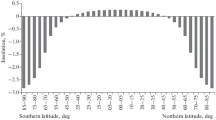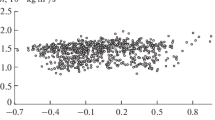Abstract
The strength of the circumpolar zonal circulation of the atmosphere in the northern hemisphere, expressed by an index calculated from the air pressure gradient between 35° N and 65°N, shows a remarkable ‘secular change’ in this century in the years 1935 to 1938, and probably again in the years after 1970. A contemporary change and parallel course with a high positive correlation can be found in a solar radiation index calculated by means of sunspot numbers and solar faculae areas. A good correlation was also found between this solar radiation index and a series of UV measurements on Mt. Wilson. The possible mechanism of action in the atmosphere will be discussed, and it is shown that this solar radiation index is also correlated with circulation parameters in the troposphere and stratosphere over Europe. There are indications of a decrease of the action from the upper to the lower atmosphere. The consequences of this secular change of circulation for the climatic history in the 20th century in Europe are presented and from that a hypothetical retrospective view of the European climatic history before the 20th century, based on the total series of sunspot numbers, is briefly discussed. In a general view with smoothed data it can be concluded that the sun seems to determine the basic structure of the north hemispheric circulation in middle latitudes, if a strong influence of sunspots and solar faculae on the solar radiation is assumed.
Similar content being viewed by others
References
Baur, F.: 1953, Linke's Meteorologisches Taschenbuch, Neue Ausgabe, II. Band, Akad. Verl. Ges., Leipzig.
Baur, F.: 1956, Physikalisch-Statistische Regeln als Grundlagen für Wetter- und Witterungsvorhersagen, 1. Band, Frankfurt a. Main.
Baur, F.:, 1957, Linke's Meteorologisches Taschenbuch, Neue Ausgabe, III. Band, Akad. Verl. Ges., Leipzig.
Baur, F.: 1964, Meteorologische Beziehungen zu solaren Vorgängen, 1. Teil: Neufestsetzung der Epochen der Minima und Maxima der Sonnenflecken, Met. Abh. Inst. f. Met. und Geophys. Freie Univ. Berlin, Band L, Heft 3.
Baur, F.: 1975, ‘Abweichungen der Monatsmittel der Temperatur Mitteleuropas vom 210-jährigen Mittelwert (1761–1970)’ in °C. Beil. z. Berliner Wetterkarte Nr. S0 19/75 vom 24.6.1975.
Dinies, E.: 1968, ‘Monatliche und jährliche Breitenkreismittel des Luftdrucks auf der Nordhalbkugel für die Jahre 1899–1967’. Ber. d. Deutsch. Wetterd., Band 15, Nr. 109.
Eddy, J. A.: 1977, ‘Historical Evidence for the Existence of the Solar Cycle’, in White, O. R. (ed.), The Solar Output and Its Variation, Colorado Univ. Press, Boulder, pp. 51–57.
Eddy, J. A., Gilliland, R. L., and Hoyt, D. V.: 1982, ‘Changes in the Solar Constant and Climatic Effects’, Nature 300, 689–693.
Eddy, J. and Foukal, P.: 1983, ‘A Summary of the Joint Discussion at Patras on Solar Luminosity Variations’, in West, R. M. (ed.), Highlights of Astronomy 6, 79–94, IAU.
Ekrutt, J. W.: 1981, Die Sonne. Gruner- und Jahr Verlag Hamburg.
Fröhlich, C.: 1977, ‘Contemporary Measures of the Solar Constant’, in White O. R. (ed.): The Solar Output and Its Variation, Colorado Univ. Press, Boulder, pp. 93–109.
Gilliland, R. L.: 1982, ‘Solar, Volcanic, and CO2 Forcing of Recent Climatic Changes’, Climatic Change 4, 111–131.
Heath, D. F. and Thekaekara, M. P.: 1977, ‘The Solar Spectrum Between 1200 and 3000 A’, in White, O. R. (ed.), The Solar Output and Its Variation, Colorado Univ. Press, Boulder, pp. 193–212.
Hoyt, D. V.: 1979.1, ‘Variations in the Solar Constant Caused by Changes in the Active Features on the Sun’, in McCormac, B. H. and Seliga T. A. (eds.), Solar-terrestrial Influences on Weather and Climate, D. Reidel, Publ. Co., Dordrecht, Holland, pp. 65–68.
Hoyt, D. V.: 1979.2, ‘Variations in Sunspot Structure and Climate’, Climatic Change 2, 79–92.
Hughes, D. W.: 1977, ‘The Inconstant Sun’, Nature 266, 405–406.
Kertz, W.: 1971, Einführung in die Geophysik, Band 2. Bibl. Inst. Mannheim, Wien, Zurich.
Leistner, W.: 1967, ‘Ueber Ergebnisse von Messungen der mittelwelligen Ultraviolettstrahlung von Hamburg und vom Mt. Wilson (1740 m) und die Beziehungen zur Ozonosphäre und den Sonnenfleckenrelativzahlen’, Met. Rundschau 20, 135–141.
Manabe, S. and Wetherald, R. T.: 1980, ‘On the Distribution of Climate Change Resulting from an Increase in CO2 Content of the Atmosphere’, J. Atm. Sci. 37, 99–118.
Manley, G.: 1974, ‘Central England Temperatures: Monthly Means 1659 to 1973’, Quart. J. Royal Met. Soc. 100, 389–405.
Mitchell, J. M.: 1975, ‘Note on Solar Variability and Volcanic Activity as Potential Sources of Climatic Variability’, in The Physical Basis of Climate and Climate Modelling, Garp Publ. Ser. No. 16, WMO Geneva, pp. 127–131.
Müller-Annen, H.: 1960, 1961, ‘Ueber die Schwankungen der Zonal-Zirkulation’, Met. Rundschau 13, 169–178 and 14, 10–17, 144–159.
Pettit, E.: 1932, ‘Measurement of Ultra Violet Solar Radiation’, Astrophys. J. 75, 185.
Ramanathan, V., Lian, M. S., and Cess, R. D.: 1979, ‘Increased Atmospheric CO2: Zonal and Seasonal Estimates of the Effect on the Radiation Energy Balance and Surface Temperature’, J. Geophys. Res. 84, 4949–4958.
Rudloff von, H.: 1967, Die Schwankungen und Pendelungen des Klimas in Europa seit dem Beginn der regelmässigen Instrumenten-Beobachtungen (1670). Vieweg und Sohn, Braunschweig.
Schmidt, M.: 1985, ‘Ozone and Sunspots: Why Can We Not Find a Direct Correlation?’ in C. S. Zerefos and A. Ghazi (eds.), Atmospheric Ozone, Proc. Quadr. Intern. Ozone Symp., 3–7 Sept. 1984, Halkidiki, Greece, D. Reidel, Publ. Co., Dordrecht, Holland, pp. 671–675.
Schwentek, H. and Elling, W.: 1981, ‘Increase in the Response of the Earth's Atmosphere to the Sunspot Cycle with Height Above Sea Level’, Solar Physics 74, 355–372.
Smith, P. A. and King, J. W.: 1981, ‘Long-Term Relationships Between Sunspots, Solar Faculae and the Ionosphere’, J. Atm. Terr. Phys. 43, 1057–1063.
Stuiver, M.: 1980, ‘Solar Variability and Climatic Change During the Current Millennium’, Nature 286, 868–871.
Voigt, H. H.: 1969, Abriss der Astronomie, 2 Bände, Bibl. Inst. Mannheim, Wien, Zürich.
Waldmeier, M.: 1941, 1955, Ergebnisse und Probleme der Sonnenforschung. Akad. Verlags-Ges. Leipzig.
Wetherald, R. T. and Manabe, S.: 1975, ‘The Effects of Changing the Solar Constant on the Climate of a General Circulation Model’, J. Atm. Sci. 32, 2044–2059.
Author information
Authors and Affiliations
Rights and permissions
About this article
Cite this article
Schmidt, M. Possible influences of solar radiation variations on the atmospheric circulation in the northern hemisphere of the earth. Climatic Change 8, 279–294 (1986). https://doi.org/10.1007/BF00161600
Received:
Revised:
Issue Date:
DOI: https://doi.org/10.1007/BF00161600




